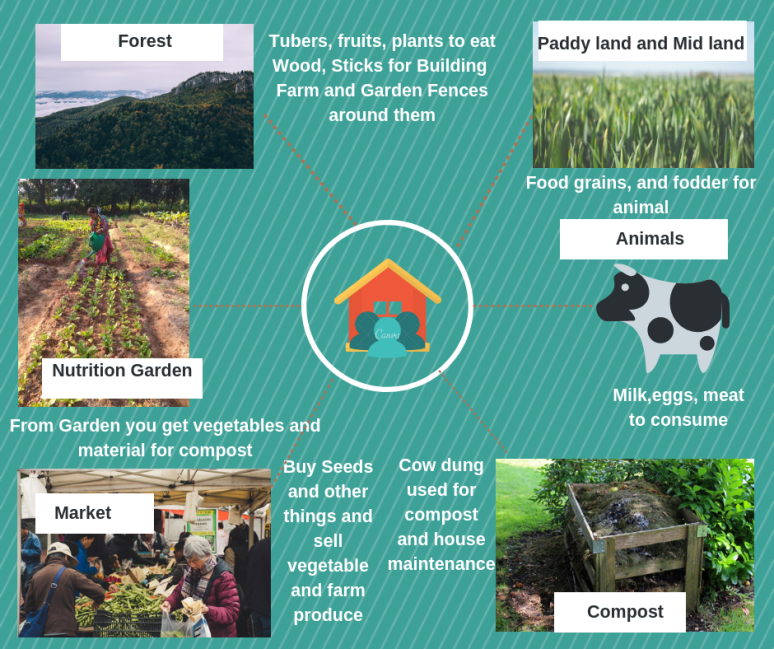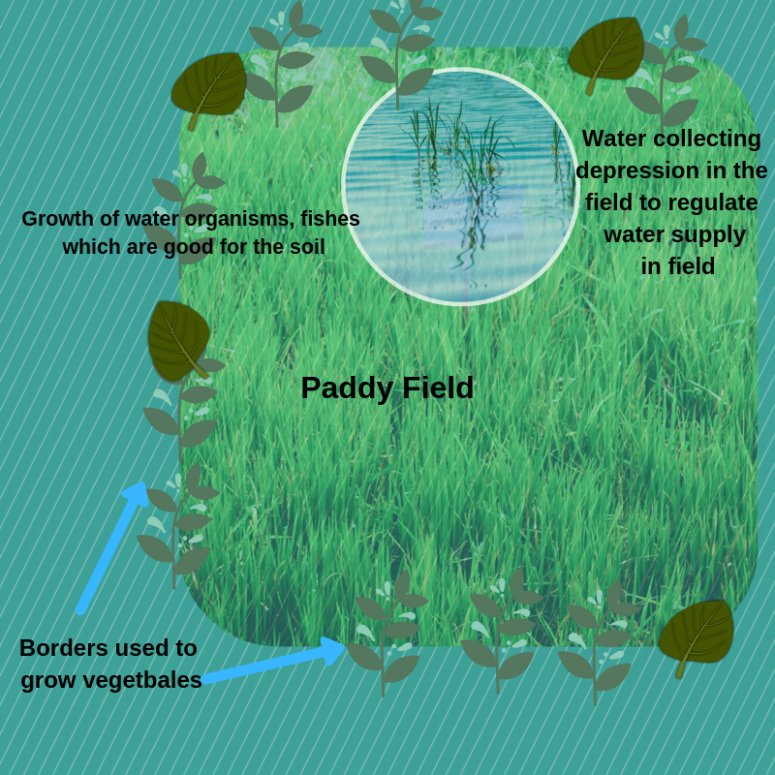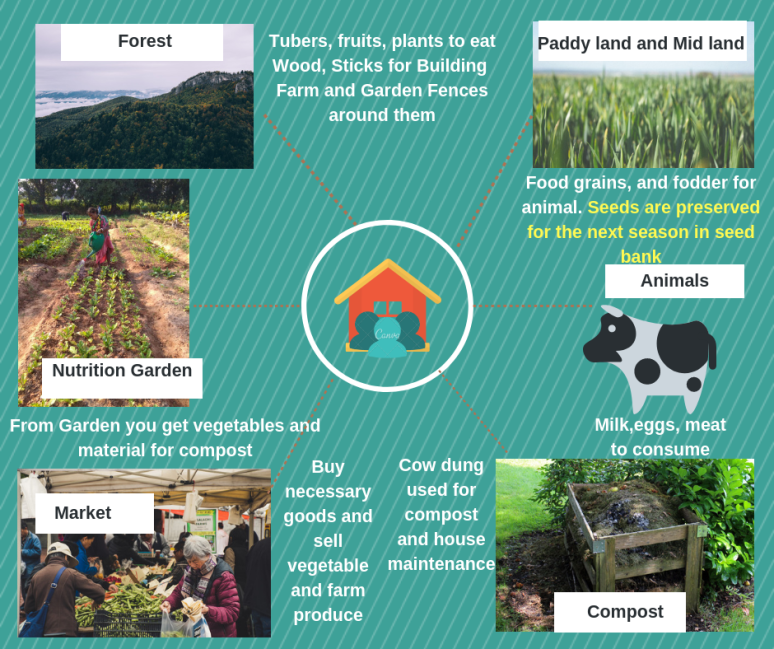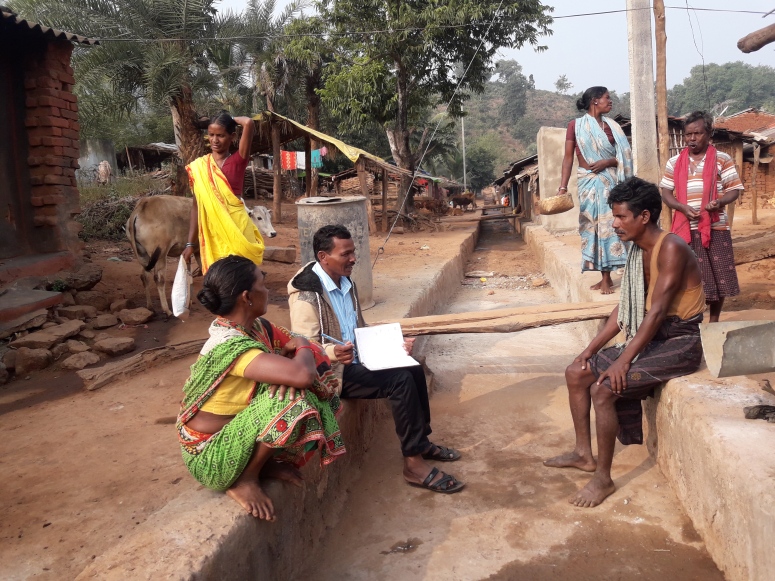The story of inter-contentedness of the farm, livestock, forest, market and the household is the story of food sovereignty. A change in the equation of each of these aspects with each other can create a different agriculture that would affect the lifestyle, culture, ecology and health. Lets us look at what this means through the story of Harishchandra Sarkar of Munda village, Jigdi Panchayat and the work of our community mobilizer Nimal. Harishchandra owns 2 acres of paddy land, 3 acres of upland and around 1 acre of hill land. He had leased his paddy land to earn income from the land leased and farmed only in the upland and hill land.
Under the Alternative Methods for Agriculture and Food Sovereignty project, Grain Banks were started in some of the villages. In the grain bank, villagers contributed finger millet, rice and fox tail millet which was managed by 10 women in the village who were responsible for the smooth functioning of the grain bank. The villagers were categorized based on the months of food stress months they face based on the amount of land they had and if their produce sustained throughout the year. The first category of villagers came under more than 3 months of food stress, 2nd category of villagers facing 2 or more than 2 months of food stress and the last category were villagers facing 1 to 2 months of food stress. Villagers took grains from the bank and returned them during the next harvest.
Harishchandra in 2010 and 2011 used the grain bank grains during the food stress months and started growing more of Turmeric in the upland. By 2012, through the help of grain bank grains to get through the stress food months and selling his turmeric produce he was able to save enough money to get bank his paddy land that was given on lease. In 2012, Harishchandra decided to join the group of farmers working with Living Farms to change their farming pattern. With this Harishchandra also started following the Integrated Farming System. See the below image to understand how the local economy is bound to the agriculture. In the image below the Household/Family is in the centre of the economy where to the left upward is its’s farming land (Both upland for paddy and midland for millets) which gives food grains to eat and fodder given to the animals. Animals give milk,eggs and meat to eat and dung for manure. This cow dung is then used in preparing compost/manure along with leaves from the forest which goes back to the soil in the farm land and also to the Nutrition Gardens where vegetables are grown. The dung is also used for house maintenance and plastering the mud walls of the house regularly and for keeping the insects away.
The food grains from the farm and the nutrition garden is consumed and the surplus is sold for money which is then used for buying other products required, health care and to buy seeds. These seeds are used to grow food grains in the farm and garden which require strong fencing that is made using the wood and sticks acquired from the forests. The forests also provide with tubers, fruits and many uncultivated foods which are consumed and also sold in the market sometimes.

In case of chemical agriculture, the farmer is dependent on the market not just for seeds but also for chemicals fertilizers and pesticides, these generally do not create healthy fodder for the animals and over the course cause accumulation of debt which often leads to the farmer leasing his land or selling his animals which makes him further dependent on chemical fertilizers and manure and no way of ploughing his land without animals.
Harishchandra when got back his land found the soil was destroyed due to chemical intensive agriculture that was practiced on it. To get back the soil in good health, he took local seeds from Living farms for paddy cultivation and also bought two cows to plough his land. He used Handi Khat, Gobar Khat and Amrut pani (organic manure and insect repellent) based on the discussions he had with Nimal and other farmers in the panchayat. Harishchandra says, “..Nimal bhai made us realize how we could use the techniques that we were already practicing more systematically to increase our yield without using chemicals in our field” In the first year 2012-13, he harvested 6 quintals of rice, in the second year 2013-14, around 9 quintals and by 2017 he harvested 12 quintals of rice in 2 acres of paddy land.
Nimal explains, “In the paddy land, we also asked Harishchandra and other farmers to grow vegetables in the corners of the land that would increase the soil health and give more yield. We also created a circular depression in the farms where water was collected and could be released in the the field in a controlled way and the good thing was that small fishes and crabs started growing there which are also very good for the health of the soil” Similarly, in the upland Harishchandra began growing more varieties of crop through seeds exchange and knowledge sharing among the farmers. In 2012, he was growing around 10-12 varieties of crops of food grains and vegetables together and by 2017 he was growing around 62 varieties.

Earlier he had 2 cows and one goat but over the years with the cows having calves and buying more animals now he has 6 cows, 10 goats and some chickens and they provide him enough manure to make compost that he does not require to buy any fertilizer. Over the years he also started conserving seeds and the farmers together formed a seed bank so that they do not have to buy seeds from the market. Thus Harishchandra has become very less dependent on the market to fulfill his food needs and is also able to produce surplus to earn income and also sometimes sells animals to earn more income if required.

Harishchandra reflects on his agriculture practice over the years and explains, “It was our knowledge but we were not using it. What was hidden knowledge is now out so that we can use it.” Nimal also points out that, “…initially it was difficult for me to convince the farmers because I realized that I had far less knowledge than them and I had to learn from them before in order to convince them to do things differently. In my initial days at the job I only followed the villagers and observed them in the field sitting there all day”


Great post!
LikeLike